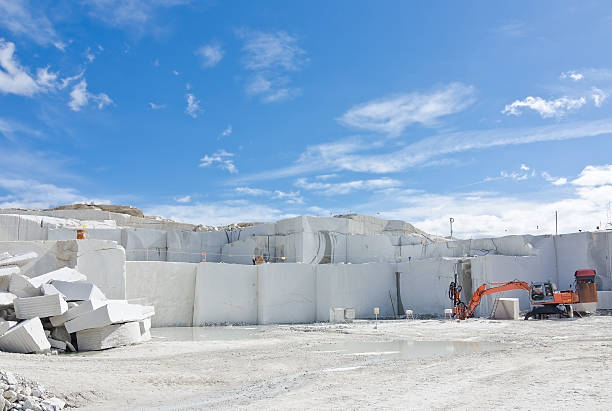Opening Natural Prizes: Granite Quarries in South Africa Introduced
Opening Natural Prizes: Granite Quarries in South Africa Introduced
Blog Article
Revealing the Mysteries of Granite Quarrying: Where Strength and Elegance Meet
The world of granite quarrying is a world where the raw strength of nature merges with human creativity to create frameworks that stand the test of time with an air of sophistication. From the midsts of quarries to the thorough polishing in workshops, the process of changing granite right into building wonders is a complex dance of tradition and innovation. As we peer right into the midsts of this ancient craft, we start to uncover the concealed intricacies that shape the very essence of our constructed environment.
The Beginnings of Granite Quarrying
In the annals of architectural history, the origins of granite quarrying are shrouded in a tapestry of old craftsmanship and geological marvels. Going back to ancient Egypt and Mesopotamia, the removal of granite from quarries noted the beginning of a journey that would at some point lead to the production of several of the world's most iconic frameworks.
Granite quarrying's origins can be traced to the experienced artisans that acknowledged the rock's durability and visual allure. Through a combination of primitive devices and sheer decision, these very early quarry employees uncovered granite blocks that would certainly become the foundation of civilizations.
As human beings progressed, so did the techniques of quarrying granite. The Romans, renowned for their design expertise, developed sophisticated techniques for removing granite to create monuments, temples, and roads that stood the examination of time.
The legacy of these ancient quarrying techniques proceeds to shape modern style, with granite staying a sign of stamina and beauty in building and construction tasks around the globe. (granite quarries in south africa)
Devices of the Quarrying Profession
The development of granite quarrying strategies from ancient civilizations to modern times highlights the essential duty played by the tools of the quarrying profession in shaping the sector's techniques. In old times, quarrying tools were simple, usually containing knives, hammers, and wedges made from materials like bronze or iron. These tools required substantial manpower and time to remove granite blocks from quarries.

In addition, the intro of pneumatically-driven tools and high-powered machinery has dramatically decreased the physical labor needed in quarrying operations, enhancing worker safety and productivity. As the quarrying sector remains to introduce, the devices of the profession remain at the leading edge of driving progression and forming the future of granite removal.
Drawing Out Blocks of Granite
Using accuracy this website equipment and advanced strategies, the extraction of granite blocks from quarries has actually become a sophisticated process in the contemporary quarrying market. The first action includes recognizing the place and dimension of the granite deposit to determine one of the most efficient extraction approach. As soon as an ideal website is picked, the extraction process starts with the drilling of holes for the placement of dynamites. Regulated blasting techniques are then used to disintegrate the granite right into workable areas.

Polishing and Completing Techniques
To achieve a perfect surface area on granite blocks, experienced artisans employ a series of thorough polishing and finishing methods. After the preliminary extraction and forming processes, the granite obstructs undertake a comprehensive sprucing up phase to enhance their natural elegance and sturdiness. One usual technique made use of in polishing granite is ruby abrasion, where commercial diamonds are utilized to grind and polish the rock to a smooth coating. This procedure not only creates a glossy surface yet additionally ensures uniformity in shade and texture across the granite block.
Along with polishing, completing methods are used to more refine the granite's appearance. These strategies might include flaming, developing, or brushing, each offering distinct appearances and coatings to match different visual preferences. Flaming, as an example, entails subjecting the granite surface area to high temperatures to create a harsh, distinctive finish, perfect for outdoor applications where slip-resistance is important. Honing, on the various other hand, offers a matte surface that is our website smooth to the touch, ideal for interior countertops and flooring. By carefully choosing and using these brightening and completing strategies, artisans can change raw granite blocks into exquisite items that display both toughness and style.

Environmental Impact and Sustainability
With the growing emphasis on ecological awareness in the industry, granite quarrying techniques are increasingly looked at for their impact on all-natural sources and long-lasting sustainability. Quarrying for granite can have considerable environmental implications. The removal process frequently includes making use of hefty equipment, nitroglycerins, and big quantities of water, causing habitat damage, dirt disintegration, and water air pollution. Furthermore, the transportation of granite from quarries to refining facilities creates carbon emissions, even more contributing to ecological destruction. granite quarries in south africa.
To reduce these influences and make sure sustainability in granite quarrying, sector stakeholders are taking on numerous actions. Carrying out advanced modern technologies to lower power consumption and water use, recovering quarried land for eco-friendly repair, and promoting accountable sourcing techniques are some approaches being utilized. Certifications such as the Forest Stewardship Council (FSC) and the Management in Energy and Environmental Style (LEED) help consumers recognize eco friendly granite items.
Final Thought
Finally, granite quarrying is a process that needs specialized devices and techniques to essence blocks of granite and polish them to a high degree of surface. While the environmental impact of quarrying can be substantial, efforts are being made to enhance sustainability practices in the sector. In general, granite quarrying is a fragile balance in between using the toughness and style of this all-natural rock while reducing its influence on the setting.
Report this page